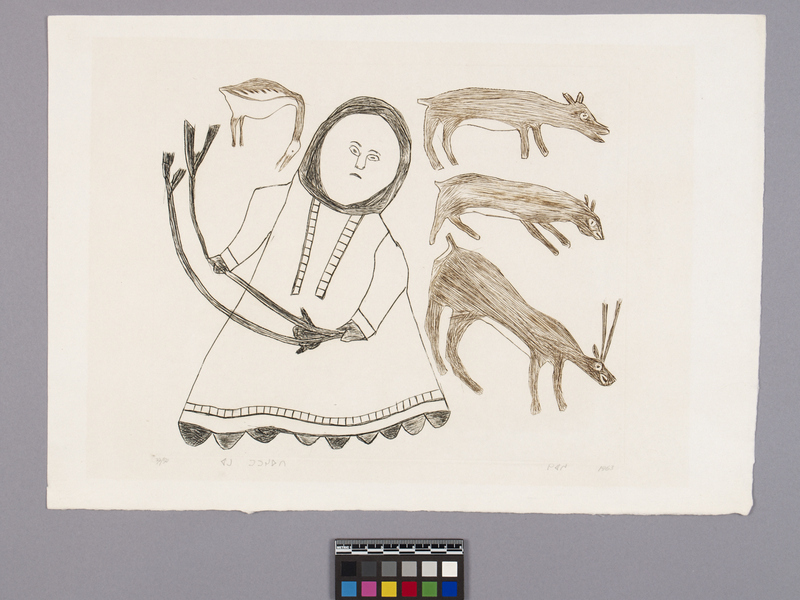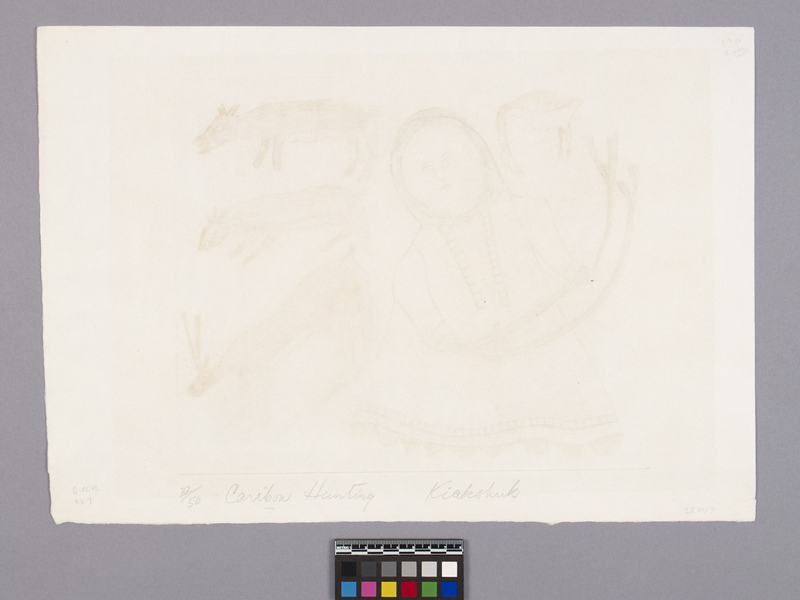Caribou Hunter Item Number: 2871/7 from the MOA: University of British Columbia


Description
Print on horizontally rectangular paper showing a image of a large figure holding antlers and a bird with long neck and head lowered in top left corner; also three brown caribou, two without antlers, one with, at right. Pencil inscription below image reads "32/50" title and artist's name in Inuit syllabics "1963". Canadian Eskimo Arts Council stamp and Cape Dorset stamp blind embossed in lower right corner.
History Of Use
Inuit prints consist mainly of stencils, stonecut engravings and lithographs from the communities of Cape Dorset, Baker Lake, Povunenituk, Holman Island, Pangnirtung and Clyde River. The first Cape Dorset prints were in 1959, Povunenituk in 1962, Holman in 1965, Baker Lake in 1970, Pangnirtung in 1973 and Clyde River in 1981. Starting in the late 1940's Indian and Northern Affairs supported the development of art from the Canadian Arctic in co-operation with the Canadian Eskimo Arts Council. Catalogues have been published since 1959 and most of the prints are documented in their year of production. A print shop was set up by James Houston in Cape Dorset in 1958 and stonecutters Igola, Eegvudluk, Luktlak and Kanangenak began training for printmaking. James Houston decided that the co-operative model would work well in the Inuit community. Specialists would prepare and cut the stone block, another artist would do the drawing and someone else would do the printing. The symbol used by the Cape Dorset group was a stylized igloo. The Cape Dorset Co-operative produces an annual catalogue illustrating and documenting prints produced within that year.
Item History
- Made by Kiakshuk (Maker) in Cape Dorset, Nunavut, Canada and Kinngait, Nunavut, Canada during 1963
- Owned by Betty Carr before March 21, 2011
- Received from Betty Carr (Donor) on March 21, 2011
What
- Name
- Caribou Hunter
- Identification Number
- 2871/7
- Type of Item
- Overall
- height 31.3 cm, width 45.0 cm
Who
- Culture
- Inuit
- Creator
- Kiakshuk (Maker)
- Previous Owner
- Betty Carr
- Received from
- Betty Carr (Donor)
Where
- Holding Institution
- MOA: University of British Columbia
- Made in
- Cape Dorset, Nunavut, Canada and Kinngait, Nunavut, Canada
When
- Creation Date
- during 1963
- Ownership Date
- before March 21, 2011
- Acquisition Date
- on March 21, 2011
Other
- Item Classes
- works on paper
- Condition
- excellent
- Accession Number
- 2871/0007